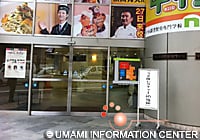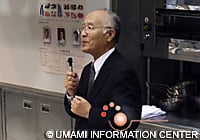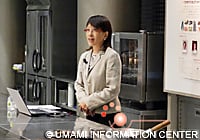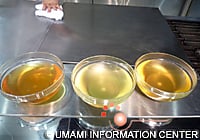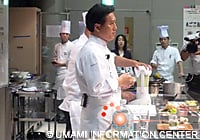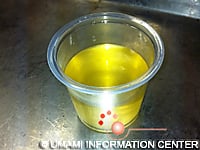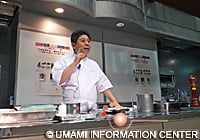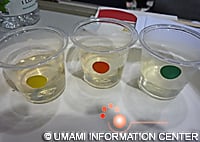---Movie uploaded!--- Activity Report 2012 Umami Lecture in Fukuoka "Let's discover umami and make the most of ingredients!"-Umami Helps to Rediscover The Charm of Kyushu Ingredients-
December 2012
◆Click to Recipe's (PDF) download
It was the second time to hold the Umami Lecture following a lecture held in Niigata last October. In the lecture, leading experts on Japanese, Chinese and French cuisines talk about the attractiveness of Kyushu ingredients that draw umami with talks and cooking demonstrations, targeting cooks, chefs, dietitians, instructors and staff of schools for cooks and culinary schools, scientists and food-conscious people in the Kyushu District, in order to help the participants have a better understanding of umami.
Two-hundred-twenty one people participated in the lecture held in a large lecture hall of Nakamura Culinary School. A picture of the lecture appeared in the Nishinippon Shimbun.
Opening remarks by Dr. Kenzo Kurihara, Chairman of the Umami Information Center, and Principal Tetsu Nakamura of Nakamura Culinary School, as co-hosts of the lecture, were followed by a lecture of Director Ninomiya on umami, one of the five basic tastes, together with her explanations from a scientific point of view about umami experience using cherry tomatoes, basic information on umami, food that contains a lot of umami substances, the mechanism of the human body that feels umami, synergy of umami and other matters.
Next, Yoshihiro Murata of Japanese cuisine, Yuji Wakiya of Chinese cuisine, and Koji Shimomura of French cuisine gave a lecture on dashi made by taking advantage of umami in each cuisine, and a demonstration of soup and umami. Furthermore, they gave a cooking demonstration of a cuisine that draws umami from Kyushu ingredients by using the dashi and soup.
In the lecture given by Yoshihiro Murata, owner of Kikunoi, participants experienced the synergy of umami by using kombu (kelp) dashi and bonito flakes first. We felt a much stronger taste of umami than the one we tasted first by drinking first only half of the kombu dashi in the cup provided to participants for tasting, then putting in our mouth and chewing bonito flakes well, and finally drinking the rest of kombu dashi. That is the synergy effect of umami. By tasting osuimono with ichiban-dashi (first broth) made by taking advantage of such effect, we could feel the taste of umami.
Next, Mr. Murata explained in a simple way by using scientific data how to make dashi, and introduced with demonstrations how to make ichiban-dashi using kombu and bonito flakes; new style dashi using dried tomatoes, dried morels, chicken breasts and salt (2% of the weight of chicken); and ago dashi using grilled flying fish and kombu.
In addition, Mr. Murata explained that dashi full of umami substances produced by the synergistic effect of glutamate and inosinate acid is nearly calorie-free, and currently receiving a lot of attention from cooks in western countries. In the tasting session held afterwards, participants tried chawan-mushi (cup-steamed egg custard hotchpotch) using new style dashi, and hiyashi (cold) takiawase (food cooked separately but served together in one dish) using ago dashi.
In the lecture given by Yuji Wakiya, Owner Chef of Wakiya and Turandot, Mr. Wakiya first explained how to make a variety of soups (tang) in Chinese cuisine, and participants tried a sample of shang tang made with his original recipe for today's lecture using Kyushu ingredients. Qing tang is the most basic soup that uses chicken and is a clear soup full of umami from the chicken. Mao tang is a soup full of umami from chicken legs (momiji) and pork bones, and is used mainly in vegetable dishes and noodle dishes. Bai tang is a soup made by continuing to boil chicken bones and pork bones on high heat until the soup turns white. It is often used as a soup for ramen in Kyushu. Shang tang is a luxury soup that is full of umami of Jinhua ham, pork ham and chicken.
In a cooking demonstration, a recipe of "Clear Soup with Umami of Pufferfish and Kurobuta Pork" was introduced first, and the participants tasted a sample. Ingredients of the soup were minced black pig meat, dried scallops, Jinhwa ham, green onions, ginger, and pufferfish bones, all ingredients from Kyushu. All the participants in the hall tasted rich clear soup full of umami substances drawn by the synergy of the glutamate in Jinghua ham, dried scallops and vegetables, and inosinate of pork. Then, Mr. Wakiya gave a cooking demonstration of "Crispy Rice with Jade-Colored Kurobuta and Pufferfish Soup" by taking advantage of the green color of qing-geng-cai leaves.
In the lecture given by Koji Shimomura, Owner Chef of Edition Koji Shimomura, Mr. Shimomura introduced dishes produced by him with their footage first, and explained the characteristics of his French dishes. Those characteristics are as follows: 1. light finish; 2. unique inspiration; and 3. explicably, definitely delicious. They are French dishes produced by making the best of the characteristics of ingredients without depending on oil and fat content, drawing the characteristics of the ingredients by using umami, and focusing on plates and food layouts. Next, participants tried a sample with vegetable bouillion that demonstrated the synergy effect of umami even with French food. The three cups prepared were as follows: (i) vegetable bouillion (with 0.3% in salt); (ii) (i) with 0.1% in umami seasoning; and (iii) (i) with minced chicken breast (1/4 of (i) in quantity). The participants tried all of them in order.
The tastes of vegetables for the first soup were fragmented and not integrated. For the next soup, the tastes of vegetables that were fragmented became integrated thanks to umami seasoning. For the last soup, we could strongly feel the taste of umami because of the synergy of the inosinic acid in the chicken and the glutamate acid in the vegetable bouillon. People in the hall looked convinced at Mr. Shimomura's explanation that although the ingredients are different from those used for Japanese dashi, the synergy of umami has also been utilized for French food.
Next, Mr. Shimomura gave a cooking demonstration of "White liver mousse and beet consomme en gelee by taking advantage of the synergy of umami, with black pepper flavor". He explained the reasons for soaking lever in milk and for using a food processor instead of a blender, revealing some of his thoughts as a cook.
Then, all participants tasted the menus of the cooking demonstrations given by Messrs. Murata, Wakiya and Shimomura, and enjoyed each dish cooked by making the best of umami.
Upper left "chawan-mushi (Savory Egg castard) eith New Style Dashi"
Upper right " hiyashi (cold) takiawase (food cooked separately but served together in one dish) using ago dashi"
Lower left "White liver mousse and beet consomme en gelee by taking advantage of the synergy of umami, with black pepper flavor"
Lower right "Rice Scorched with Jade-Colored Kurobuta and Pufferfish Soup"
Finally, a Q&A session was held regarding today's lecture, followed by some comments by the three chefs, and then instructors and students of Nakamura Culinary School were introduced. The Umami Lecture was closed with the closing remarks of Dr. Takashi Yamamoto, Vice Chairman of the Umami Information Center. We received high evaluations from the participants, stating that: they fully understood that umami is common among Japanese, Chinese and French cuisines; they enjoyed the delicious meal made by the top chefs taking advantage of umami; and they hoped that this kind of lecture will be held again.
The Umami Information Center will continue this kind of activity for a better understanding and spread of umami. We look forward to your continued support.
